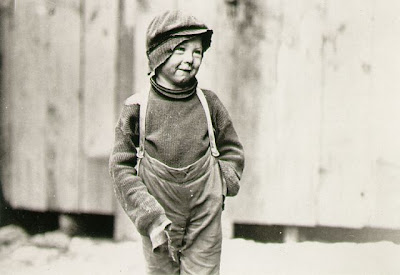Lewis W. Hine, American, 1874-1940 
Lewis
Hine, who was best known for his use of photography as a means to
achieve social reform, was first a teacher of botany and nature studies
at the Ethical Culture School in New York. It was while he was teaching
that he was given a camera by the head of the school. In his hand, the
camera became a powerful means of recording social injustice and labor
abuses.
Hine's
interest in social welfare and in reform movements led him in 1905 to
begin his first documentary series; immigrants on Ellis Island. In 1908
he left teaching to become an investigator and photographer for the
National Child Labor Committee (NCLC), and between 1908 and 1916 he
traveled extensively photographing child-labor abuses. Hine would manage
to gain access to the sweatshops and factories where children were
employed, and then, if he could, photograph them at work. Hine inveigled
his way into factories by posing as an insurance agent, bible salesman,
postcard seller, or industrial photographer. Once inside, Hine quickly
would go about his business of photographing the children working.
Having been a teacher, Hine was comfortable talking with children and
would attempt to get as much information as possible regarding their
living conditions, the circumstances under which they were forced to
work, and their name and age. If he was unable to determine a child’s
age by speaking to him, Hine would surreptitiously measure the child’s
height against the buttons on his vest and estimate the child’s age by
his height. If Hine was not able to gain admittance to a factory, he
would wait outside the gates and photograph the children as the came to
work. He visited children and families who worked at home and he wrote
with impassioned sarcasm of the "opportunities for the child and family
to enlist in the service of Industry."
Hine's
photographs were used to make lantern slides for lectures and to
illustrate pamphlets, magazine articles, and exhibitions. Through his
photographs, Hine was able to inspire social change. His photos
documenting the horrid conditions under which children were employed,
made real the plight of these children. This led to the passage of child
labor laws. Not only did Hine document the horrors of work, he also
depicted the dignity of labor. This is best seen in his photos of the
construction of the Empire State Building. From 1930 to 1931 he took
hundreds of pictures of the Empire State Building under construction.
These photos, as well as photographs of factory workers and other
laborers, were published in Men at Work. While Hine's early
photographs were often published, by the 1930s, interest in his work had
declined. In 1938 he was denied a grant to photograph American crafts
people at work. The Photo League in New York publicized his work, but it
was not until a number of years after his death that he again received
wide recognition. A new monograph was recently printed entitled, Lewis W. Hine Children At Work by Vicki Goldberg.























































